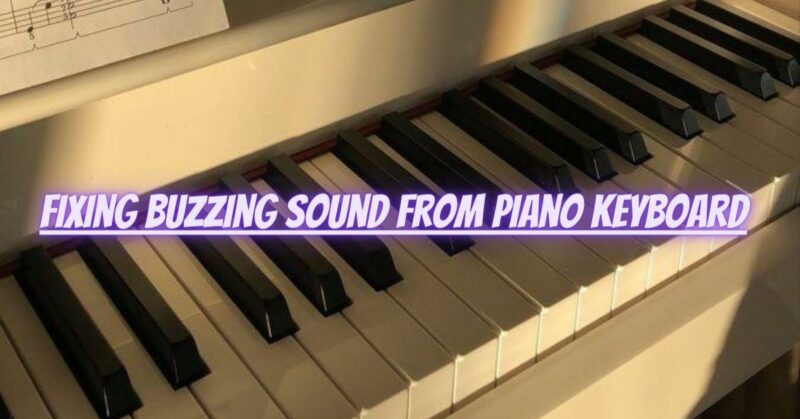A buzzing sound from your piano keyboard can be disconcerting and diminish the enjoyment of your playing experience. Buzzing noises can stem from various factors, ranging from minor issues to more significant problems. If you’re dealing with this issue, don’t worry—there are common causes for buzzing sounds, and in this article, we’ll explore the likely reasons and offer practical solutions to fix the buzzing sound and restore your piano keyboard’s optimal performance.
1. Check for Loose Screws or Components:
Vibrations from playing the keys or external factors can sometimes cause screws or other components inside the piano keyboard to become loose, leading to buzzing sounds.
Solution:
- Gently inspect the exterior of the piano keyboard for any visibly loose screws or components. If you find any, carefully tighten them using the appropriate tools.
- Avoid over-tightening, as this can cause damage. If you’re unsure, seek the assistance of a qualified piano technician.
2. Clean the Keyboard and Keys:
Dust and debris can accumulate between the keys or inside the keyboard, resulting in buzzing noises when the keys are struck.
Solution:
- Use a soft, lint-free cloth to clean the keys and the spaces between them.
- If there are hard-to-reach areas, consider using compressed air to blow away any trapped dust.
3. Check the Pedals:
Sometimes, buzzing sounds can originate from the piano’s pedal mechanism or connections.
Solution:
- Inspect the pedal unit for any loose parts or connections. Tighten any loose screws or connections as needed.
- If you have a separate pedal unit connected via MIDI, ensure that the MIDI cables are securely plugged in.
4. Check the Piano’s Structure:
Buzzing sounds can occur if the piano’s structure is compromised, such as loose panels, soundboard, or resonance parts.
Solution:
- Carefully tap on different parts of the piano while listening for any rattling or buzzing sounds. Identify the source of the noise.
- If the buzzing is originating from inside the piano, it’s best to seek professional assistance from a piano technician to diagnose and repair the issue.
5. Address Damaged or Worn Components:
Worn or damaged components, such as strings, hammers, or dampers, can contribute to buzzing sounds.
Solution:
- If you notice any visibly damaged or worn components inside the piano, contact a qualified piano technician for evaluation and repair.
- Regular piano maintenance and tuning will help prevent or address potential issues with worn parts.
6. Address Environmental Factors:
Changes in temperature and humidity can affect the materials of the piano, leading to buzzing sounds.
Solution:
- Keep your piano in a stable environment with controlled humidity levels to minimize the impact of temperature and moisture changes.
7. Seek Professional Assistance:
If the buzzing sound persists despite your efforts or if the issue involves complex internal problems, it’s best to seek professional assistance.
Solution:
- Contact a qualified piano technician to inspect the piano and identify the source of the buzzing sound.
- They can recommend appropriate repairs or adjustments to resolve the issue.
Conclusion:
A buzzing sound from your piano keyboard can be addressed through systematic troubleshooting and maintenance. By checking for loose screws or components, cleaning the keyboard, inspecting the pedal unit, and addressing any worn or damaged components, you can often fix buzzing noises. Regular piano maintenance and care, along with proper environmental conditions, will contribute to a harmonious and enjoyable piano-playing experience. However, if the buzzing persists or involves complex internal issues, seeking the expertise of a qualified piano technician will help diagnose and resolve the problem effectively. With a buzzing-free piano keyboard, you can fully immerse yourself in the joy of music and continue to create beautiful melodies with confidence and ease.


